![[Jump to Cover]](cover.gif) |
![[Jump to Contents]](contents.gif) |
![[Jump to Introduction]](introduc.gif) |
![[Jump to Concepts]](concepts.gif) |
![[Jump to Realization]](realiza.gif) |
![[Jump to Conclusion]](conclusi.gif) |
 |
|
|
Appendix
This appendix contains four sections:
A Presentation Slides
- After the completion of the practical work on the diploma thesis, this presentation has been given to professors and students of the department.
B Program Code Listings
- For the models that have been created to test the Crickets’ extended abilities, the program source code is provided in this section. It has been explained where necessary.
C Glossary
- Technical terms and abbreviations that have been used in this documentation are listed in the glossary. Each of them has been explained in a few words.
D Literature and Links
- This is a compilation of the literature that has been quoted in the documentation. In addition, some links to Web sites have been added, where further information can be found.
A Presentation Slides
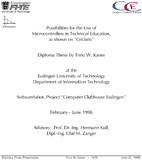 |
 |
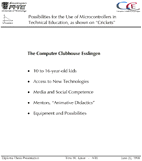 |
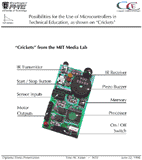 |
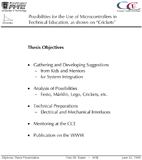 |
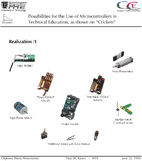 |
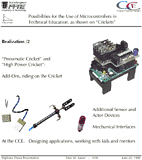 |
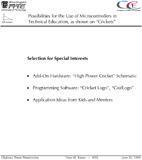 |
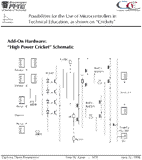 |
 |
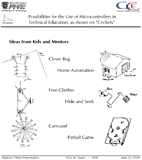 |
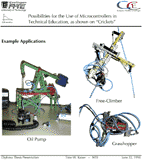 |
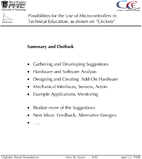 |
These presentation
slides have not been included as GIF files due to their size (200 by 200
mm at 300 dpi).
However, the complete set of slides may be downloaded in PDF format at the end of this page. |
|
B Program Code Listings
- Model "Oil Pump"
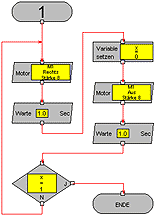 |
To the left, there is a screen
print of the control program as it has been implemented in GrafLogo. The
desired endless loop has been created using a condition that will never
become true.
The lines below show the plain Cricket Logo program for the same functionality. to pump |
- Model "Grasshopper"
This is the Cricket Logo code that has been written to control the Grasshopper. Note: A small camcorder remote has been used instead of the TV remote. This makes the program more complicated, as the standard procedure calls in Cricket Logo cannot be used. They expect the number keys 1 through 7 to be pressed, which are not available on this camcorder remote.global [a]If a standard Sony TV remote had been used, the global variable as well as the ‘main program’ (procedure ‘jump’) would not have been needed. Instead, the first five lines (‘command lines’) on the left side of the Cricket Logo window would take the procedure calls, i.e., ‘both’, ‘bjump’, ‘fjump’, ‘rear’, and ‘front’.to jump
loop [
seta ir
wait 1
seta ir
if a = 153 [ both ]
if a = 155 [ bjump ]
if a = 156 [ fjump ]
if a = 152 [ rear ]
if a = 154 [ front ]
wait 1
]
endto both
ab, thisway on
wait 2
ab, off
endto bjump
a, thisway on
wait 1
b, thisway on
wait 1
a, off
wait 1
b, off
endto fjump
b, thisway on
wait 1
a, thisway on
wait 1
b, off
wait 1
a, off
endto rear
b, thisway on
wait 2
b, off
endto front
a, thisway on
wait 2
a, off
end
- Model "Free-Climber"
This model’s program is quite similar to the one before. The procedure calls ‘climbup’ and ‘climbdown’ have been placed in the first two of the Cricket Logo command lines.to climbup
b, thisway on wait 8
a, thisway on
b, off wait 8
a, off
endto climbdown
a, thisway on
b, thisway on wait 8
a, off
b, off wait 8
end
D Glossary
This collection tries to explain some special terms and abbreviations that are used in this documentation. Among them there are expressions related to electronic circuits, computer hardware or software, new media technology like the Internet, and the Computer Clubhouse Esslingen project in general.Although being far from complete, this alphabetical list may serve as a quick reference for the reader, and is placed at the end of the documentation for this purpose.
Acrobat Reader
Program / Plug-In by Adobe, necessary to view PDF files in a separate window or within the browser, respectively. The Plug-In version can be integrated into the Web browser software to display PDF files within the browser’s window. Both Acrobat versions are available from Adobe free of charge.
Beta
Pre-release stage of a product. This is the time when you give the program to selected people and ask them to test it for bugs and usability.
Browser
Software that is used to navigate through the World Wide Web, an Intranet, or local file systems. It analyses hyperlinks and commands embedded in HTML documents, and uses this information to format and display the contents of those documents.
Cache
Temporary data storage using either CPU, RAM, or local hard disk. It holds some lately viewed data and speeds up the loading time if the same data is to be used again.
CCE
Computer Clubhouse Esslingen. An institution of the Softwarelabor at the Esslingen University of Technology. CCE is embedded in the Computer Clubhouse Network.
Chat
On the Internet, chatting means that two or more people have a virtual conversation under near real-time conditions: They see a line of text written by a partner and immediately reply to this by typing a message of their own. Compared to eMail, this is faster and less formal. If eMail is the fax machine, chatting is the telephone.
CPU
Central Processing Unit. As the ‘mind’ of a computer, it does all the calculations necessary to execute the program code. Surrounded by memory and interfaces, the CPU can interact with the user and connected peripherals.
Duplex
"Two-way": Communication can take place in both directions. While in half-duplex mode, the partners alternate at transmitting information, full-duplex means that both of them can transmit and receive at the same time (like on the telephone).
EEPROM
Electrically Erasable Programmable Read-Only Memory. Special kind of ROM that can be rewritten several times. Compared to RAM chips, EEPROM is very slow but can store the contained information for years without power.
Festo
Among other products, the Festo company designs and produces pneumatic systems and accessories. Festo provided the CCE with the pneumatic equipment that has been used in this project.
FHTE
Abbreviation for: Fachhochschule Esslingen, Hochschule für Technik – Esslingen University of Technology.
Fischer
Company producing the "fischertechnik" toy system, which basically contains plastic bars. These are assembled in a tongue-and- groove manner and features many special parts for building up complex models of realistic functionality.
Frame
Since the year 1997, all new browser software can subdivide their display window into several areas. Although their borders are not necessarily visible, these areas are called frames. It is popular to display a navigation bar in the left or bottom part of the screen. However, new generations of hand-held computers and TV add-ons (‘set-top boxes’) are being developed at this time, which will not support frames (and no JavaScript, either). This was the reason for not using frames on the Web pages accompanying this documentation.
GIF
Graphics Interchange Format. Popular file format for images that are embedded in HTML documents. It uses lossless compression to create fairly small files of high quality. While supporting only 256 different colors in a file, it can treat one color as transparent, so you can see the browser’s background color though those areas.
Half-duplex
See duplex.
HTML
Hypertext Markup Language. A hypertext document contains words or images, which are linked to other texts or resources. These ‘hot’ areas are called hyperlinks. The way how these and other features are inserted into the texts is described by HTML. The files are still ordinary text files that contain so-called tags. To identify them as hypertext documents, their file name extension is ‘.htm’ or ‘.htm’. Since the World Wide Web has been invented, HTML has evolved into the standard language for Internet documents.
HTTP
Hypertext Transfer Protocol. As a prefix to an Internet address (URL), ‘http:’ tells the browser application how to handle the desired document. There are other protocols as well, e.g., ‘https:’ (Secure HTTP) and ‘ftp:’ (File Transfer Protocol).
Hyperlink
See HTML.
IR
Abbreviation for infrared. Infrared radiation has a wavelength that is slightly lower than that of visible light. Like TV remote controls, Crickets use wireless communication via infrared light to share data with each other. They are also programmed by IR transmission.
ISO
International Organization for Standardization, Geneva, Switzerland. Develops international norms and standards.
JavaScript
Scripting language developed by Netscape as an open standard to be integrated in HTML code. Interpreted while being loaded, the scripts interact with the browser software and the document in which they are embedded and add a lot of features to plain HTML. Since 1997, all new browsers support JavaScript. However, new generations of hand-held computers and TV add-ons (‘set-top boxes’) are being developed at this time, which will not support JavaScript (and no frames, either). This was the reason for not using JavaScript on the Web pages.
Lego
The Lego Company has become famous for their toy system based on colorful plastic bricks. "Lego Technic" adds a lot of special parts to this system, allowing to create functional models that can even be powered by electric motors. Lego intends to design a commercial microcontroller system to integrate robotics applications into their palette of products.
Märklin
Founded in 1859, Märklin is one of the most experienced companies in metal toy manufacturing. Having always been up-to-date, Märklin is nowadays famous for their pioneer work on digitally controlled model railways. The Märklin Metall construction system is based on the "Meccano" kits patented in 1907 by Frank Hornby, England.
Portable Document Format. A compressed file format that is popular to distribute printable information on the Internet or disks. While text and line art is stored in resolution-independent vector format, images are reduced in resolution and compressed to be included in PDF. The Acrobat software needed to read the files is available free of charge. This documentation is also published in PDF format.
Plug-In
Software module which can be integrated into a browser. It extends the browser’s abilities so that other than the standard file types can be viewed within the browser window. Another kind of browser extensions are stand-alone programs that are called by the browser when trying to display non-standard files. These are called helper applications and display the contents in their own windows.
ROM
Read-Only Memory. In contrast to RAM, the information stored in ROM chips cannot be deleted or replaced. An exception to this definition is EEPROM.
Search Engine
Database service on the WWW. Most search engines browse the Internet at night and store the information they can find in a database of key words. This database can be queried by anybody’s browser software to look for information sources.
Softwarelabor
An institution at the Esslingen University of Technology (see FHTE). The Computer Clubhouse Esslingen is one project within the Softwarelabor.
URL
Uniform Resource Locator. The unique address of a document on the Internet. E.g., the URL for the CCE’s homepage is http://www.cce.fht-esslingen.de, where the first part (before the double slash) tells the browser software what kind of connection to establish. There are also URLs starting with ‘https:’, ‘ftp:’, or ‘gopher:’.
Vias
On a printed circuit board with two or more layers: Connectors between layers.
Web
Short form for World Wide Web (see WWW).
WWW
World Wide Web. Refers to the graphical part of the Internet, which the user can browse or ‘surf’ by following hyperlinks embedded in Web documents (see HTML).
ZIP
Compressed file format. ZIP is the most popular format for compressing data on the Internet. Compression ratio varies significantly depending on the kind of data to be compressed. Text files can be compressed very well, while GIF images for example are already compressed, so the ZIP compression will hardly reduce their size.
E Literature and Links
The literature quoted or mentioned in this thesis has been listed here in the order in which it first appears in the documentation. A compilation of Internet links related to the project is provided afterwards.| [1]: | Softwarelabor at the Esslingen University of Technology, brochure "Informationen zum Computer Clubhouse Esslingen", Esslingen 1997 |
| [2]: | Horst W. Opaschowski, "Pädagogik der freien Lebenszeit", Opladen 1996 |
| [3]: | Softwarelabor at the Esslingen University of Technology, "Free Access To ‘Hands On’ Experience In Technology, Communication And Multimedia", Esslingen 1998 |
| [4]: | Gail Breslow, Computer Clubhouse Director, The Computer Museum, Boston, USA; quoted from: Softwarelabor at the Esslingen University of Technology, brochure "Leitfaden für Mentorinnen und Mentoren", Esslingen 1997 |
| [5]: | Jörg Knaupp, thesis on "Konzeption und Aufbau eines Multimedia WWW-Servers für Jugendliche", written at the Computer Clubhouse Esslingen, 1998 |
| [6]: | "Cricket Logo – Language Reference" by Fred Martin and Robbie Berg, Epistemology and Learning Group, Media Laboratory, Massachusetts Institute of Technology, 1997 |
| [7]: | Jörg Kefer, thesis on "Konzeption und
Erstellung einer grafischen Programmieroberfläche für einen Automatisierungsbaustein
(Cricket)", written at the Computer Clubhouse Esslingen, 1998
|
| [a]: | http://www.cce.fht-esslingen.de – Computer Clubhouse Esslingen |
| [b]: | http://lcs.www.media.mit.edu/people/ |
| [c]: | http://www.festo.com – Festo company homepage (Pneumatics) |
| [d]: | http://www.maerklin.de – Märklin company homepage (Märklin Metall kits) |
| [e]: | http://www.lego.com – Lego company homepage (Lego Technic system) |
| [f]: | http://www.microchip.com – Microchip company homepage (PIC processors) |
Although not always mentioned in the text, all company names, products, and trade marks are of course recognized and fully respected.
|
|